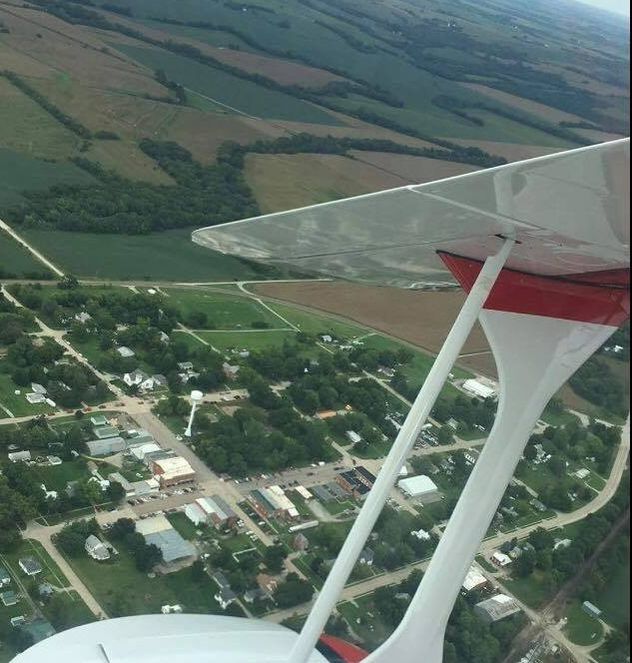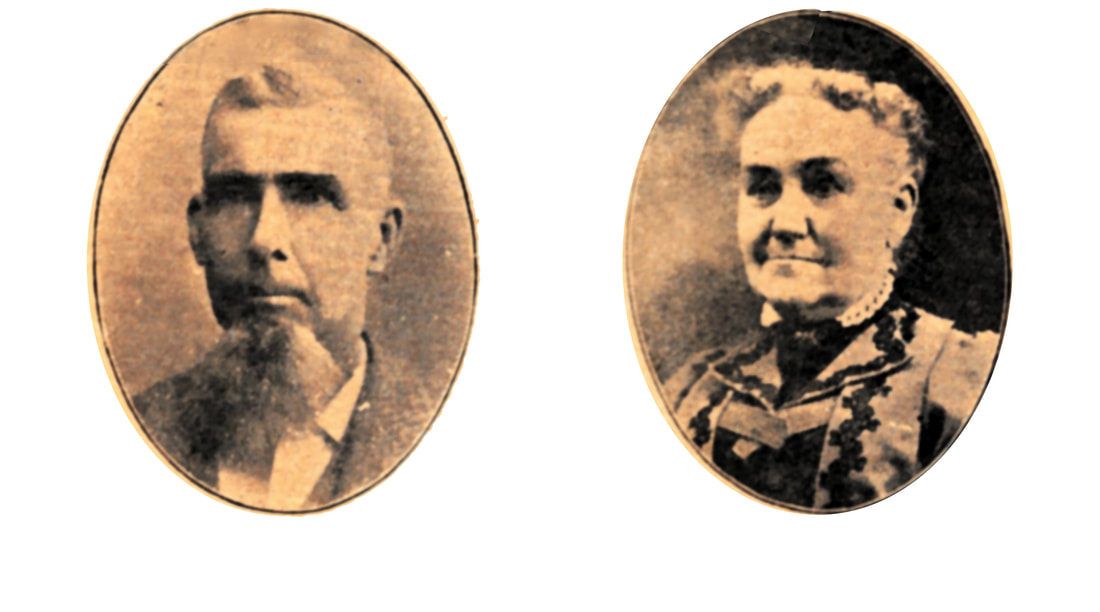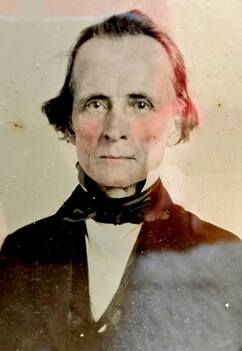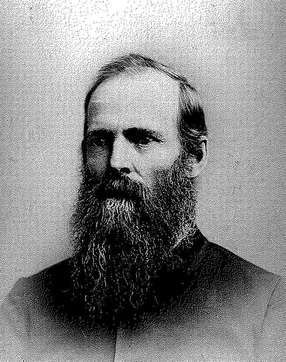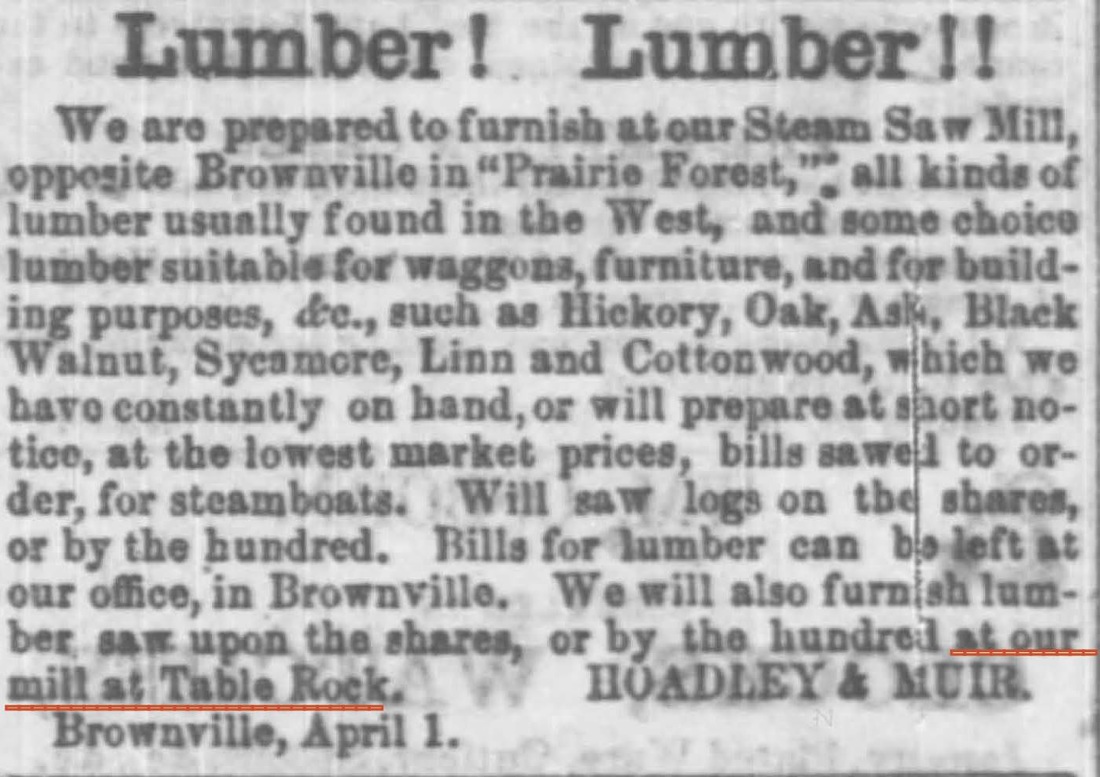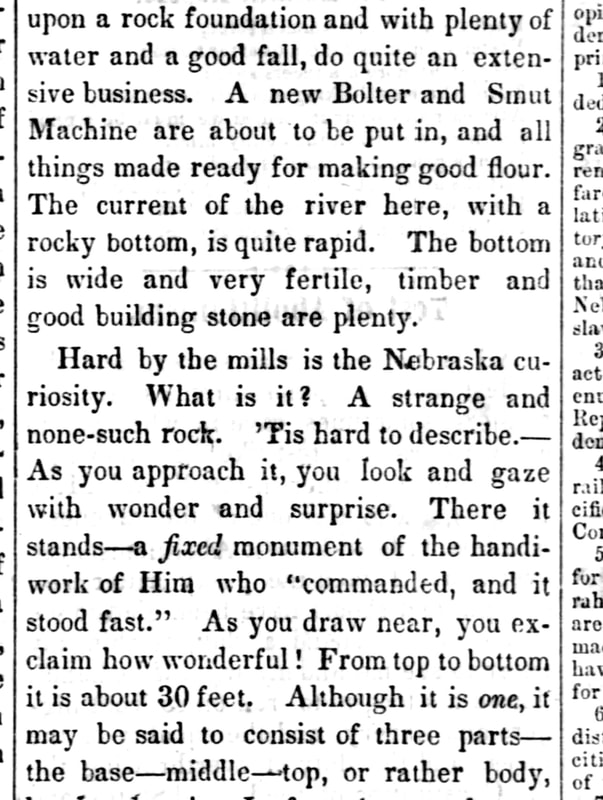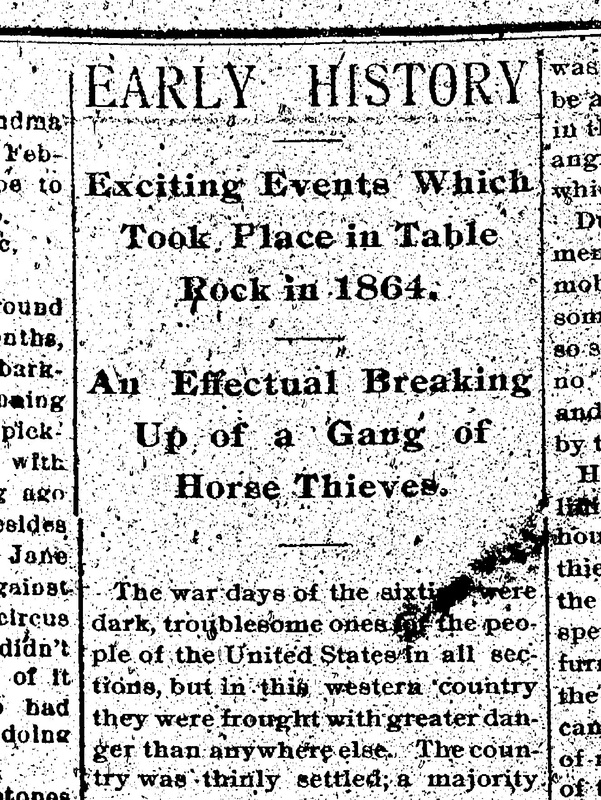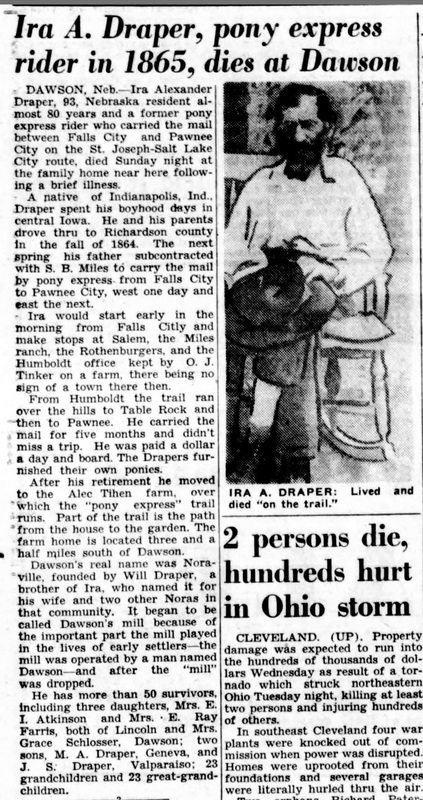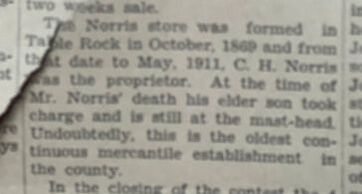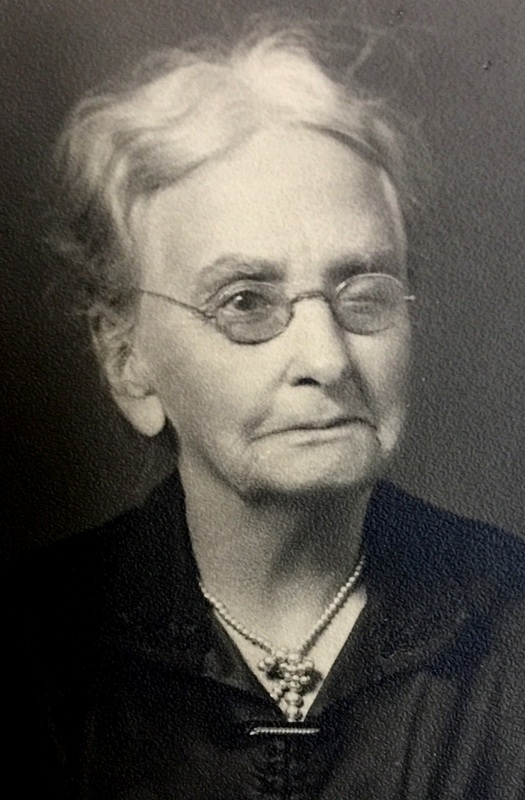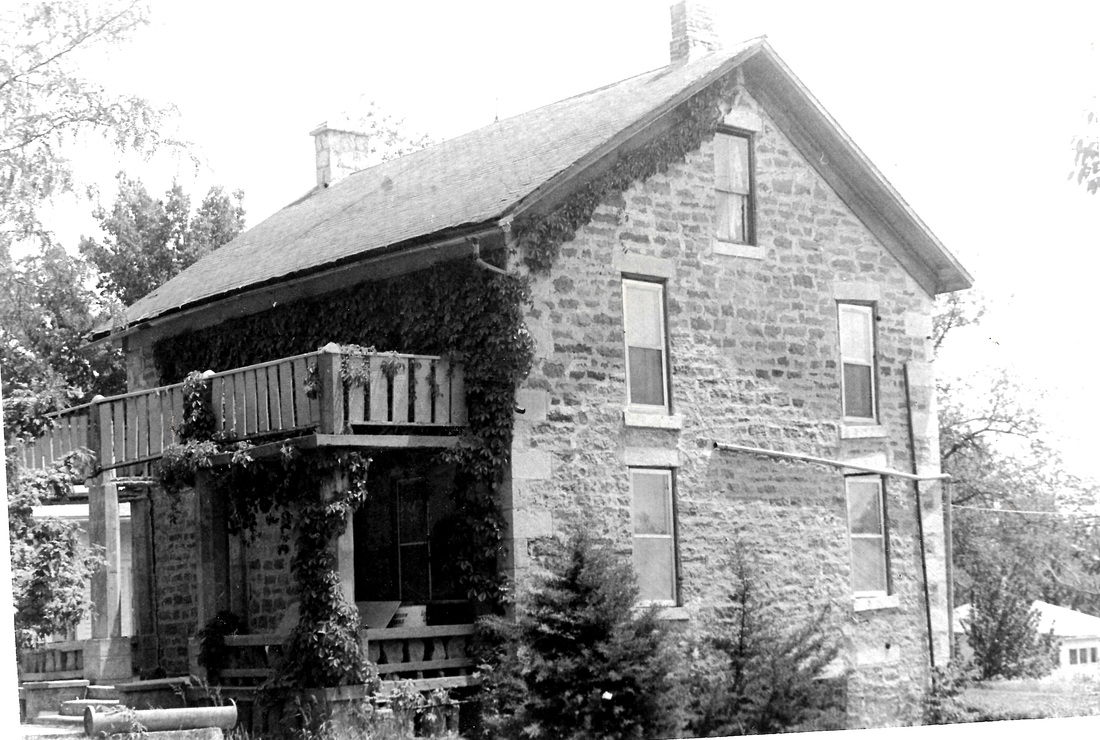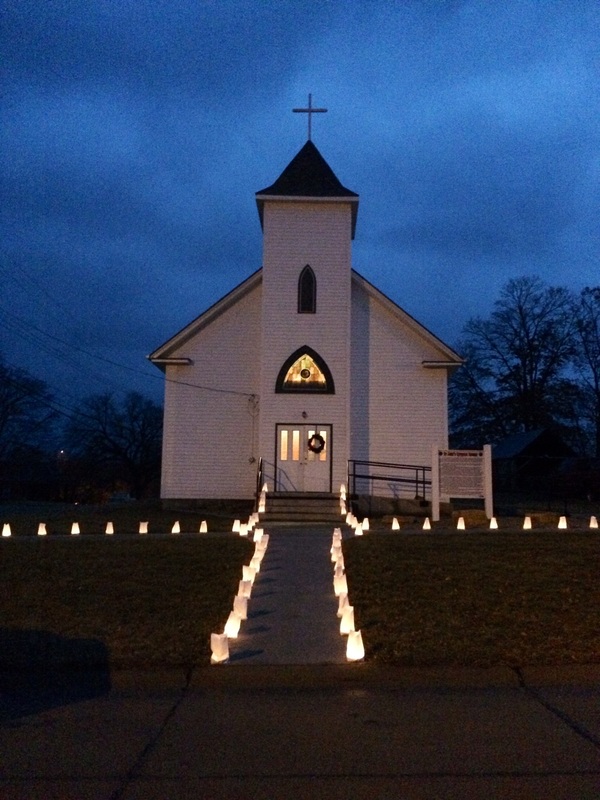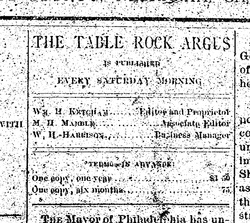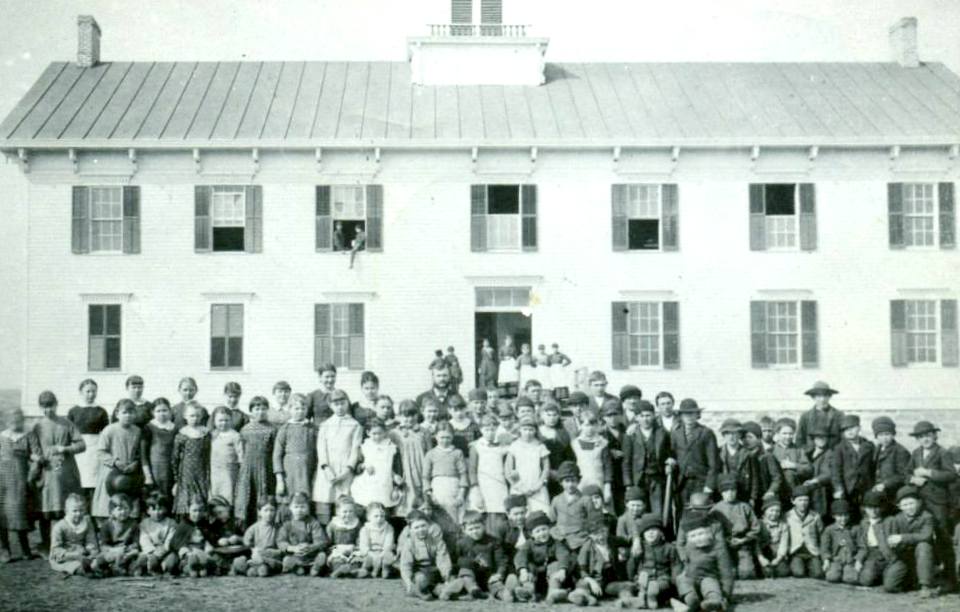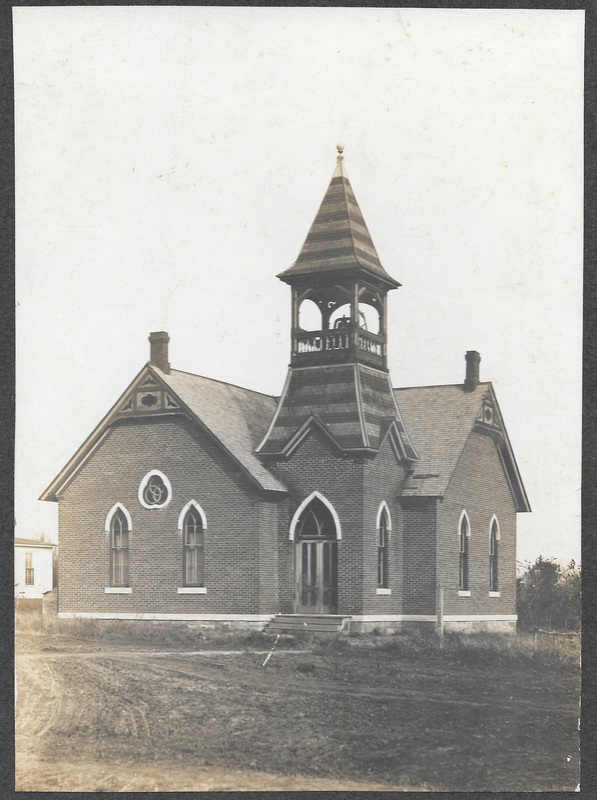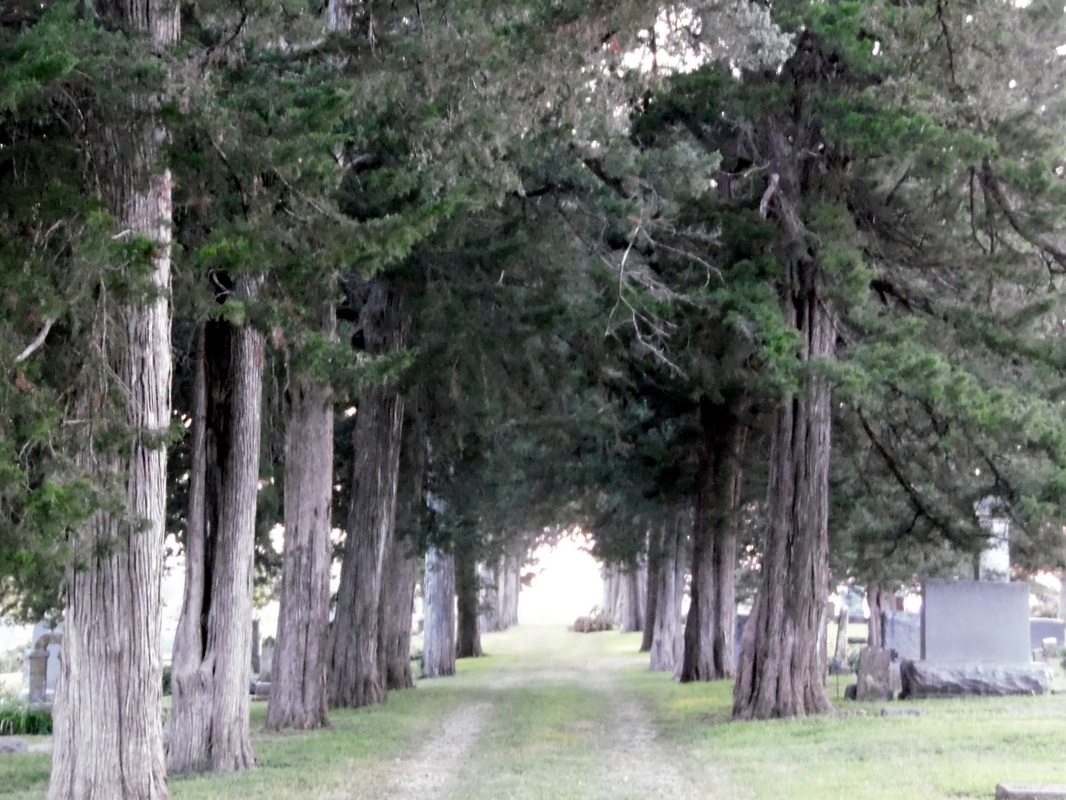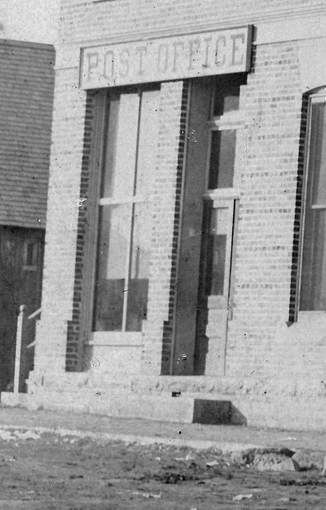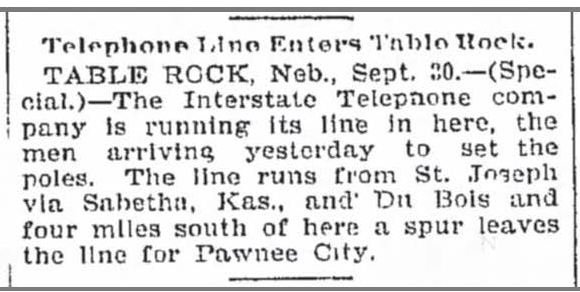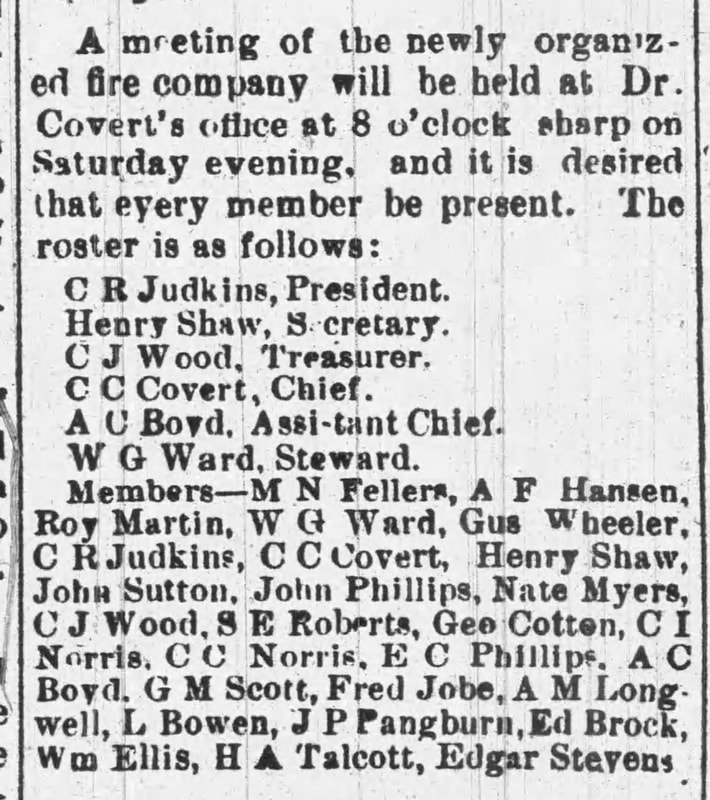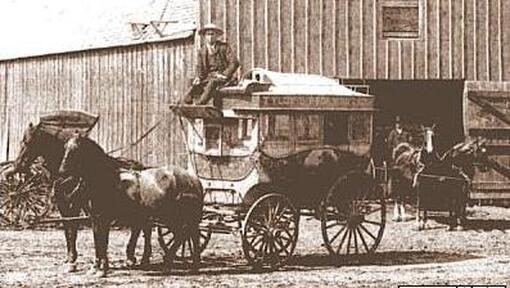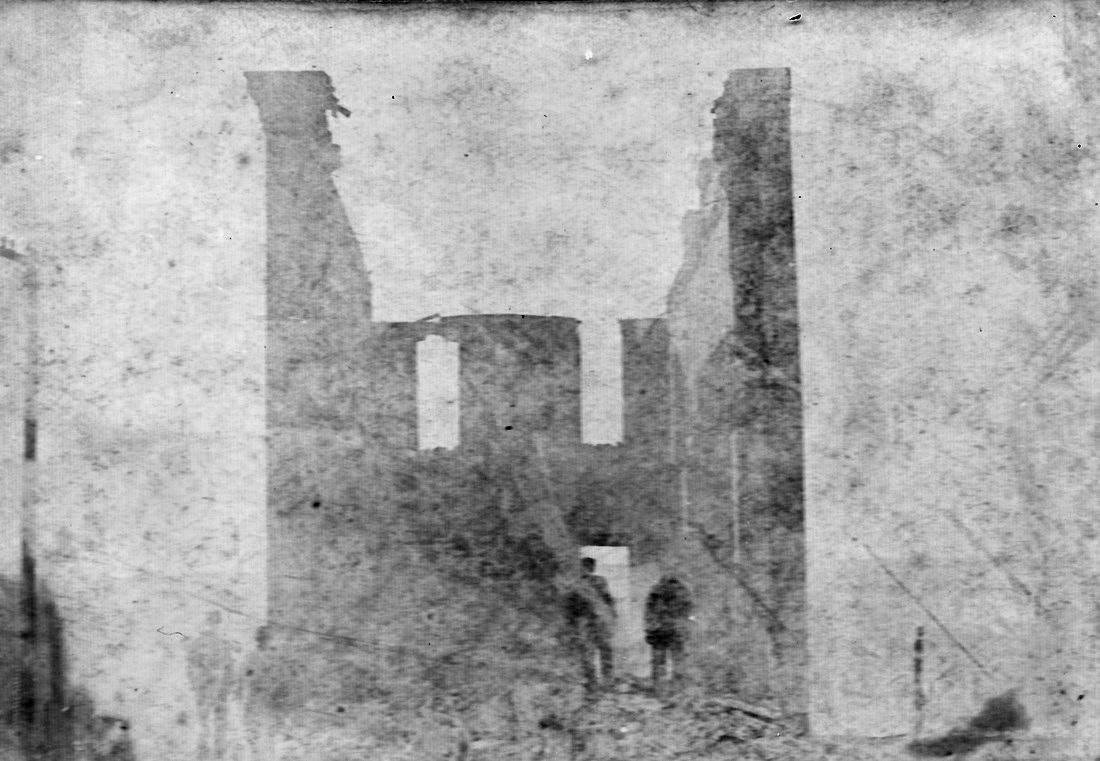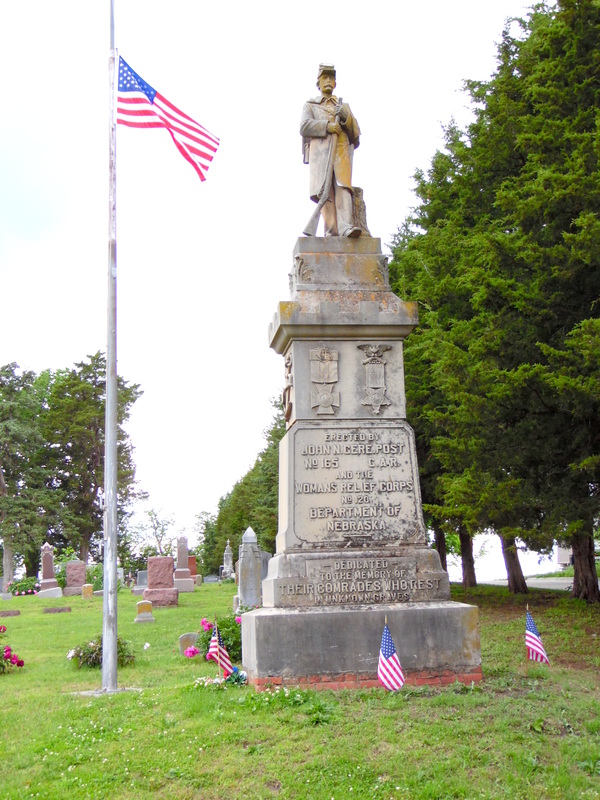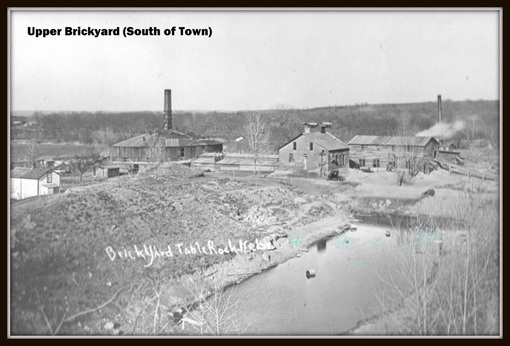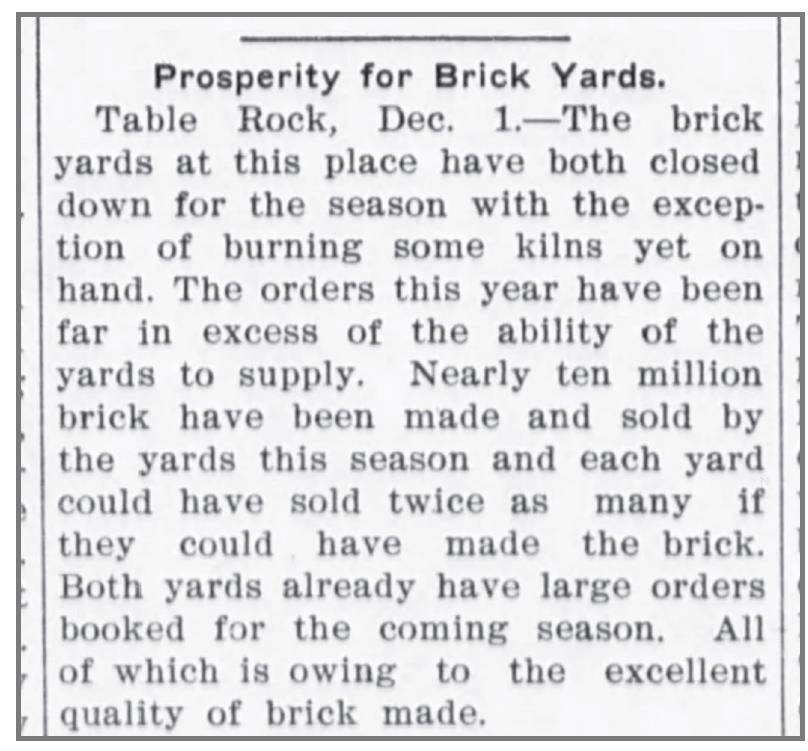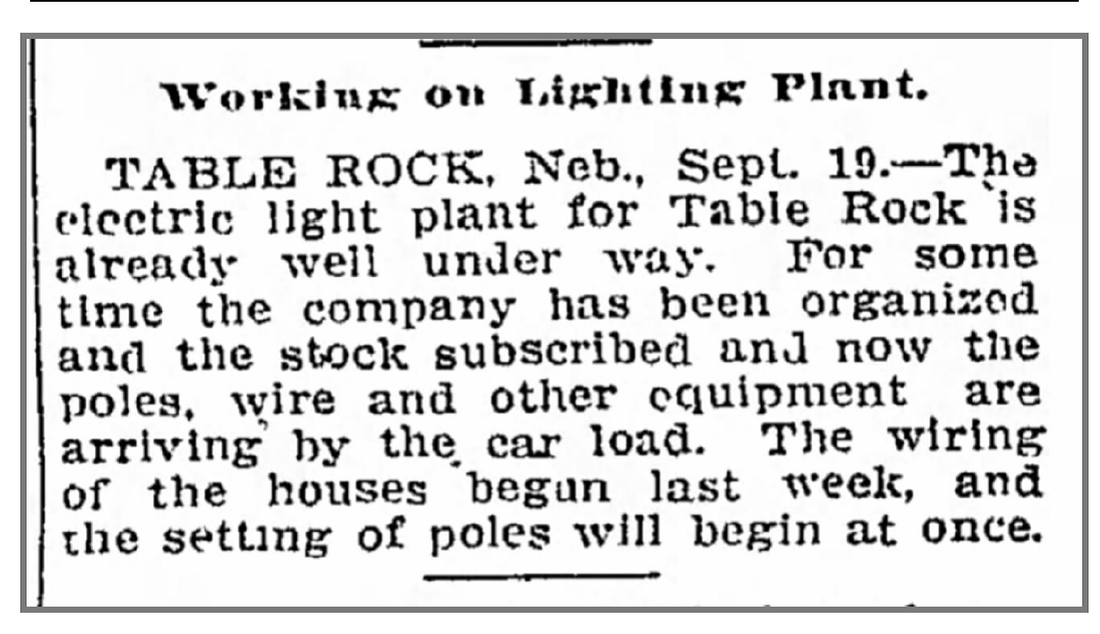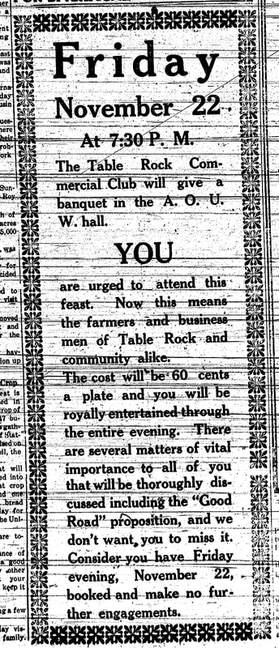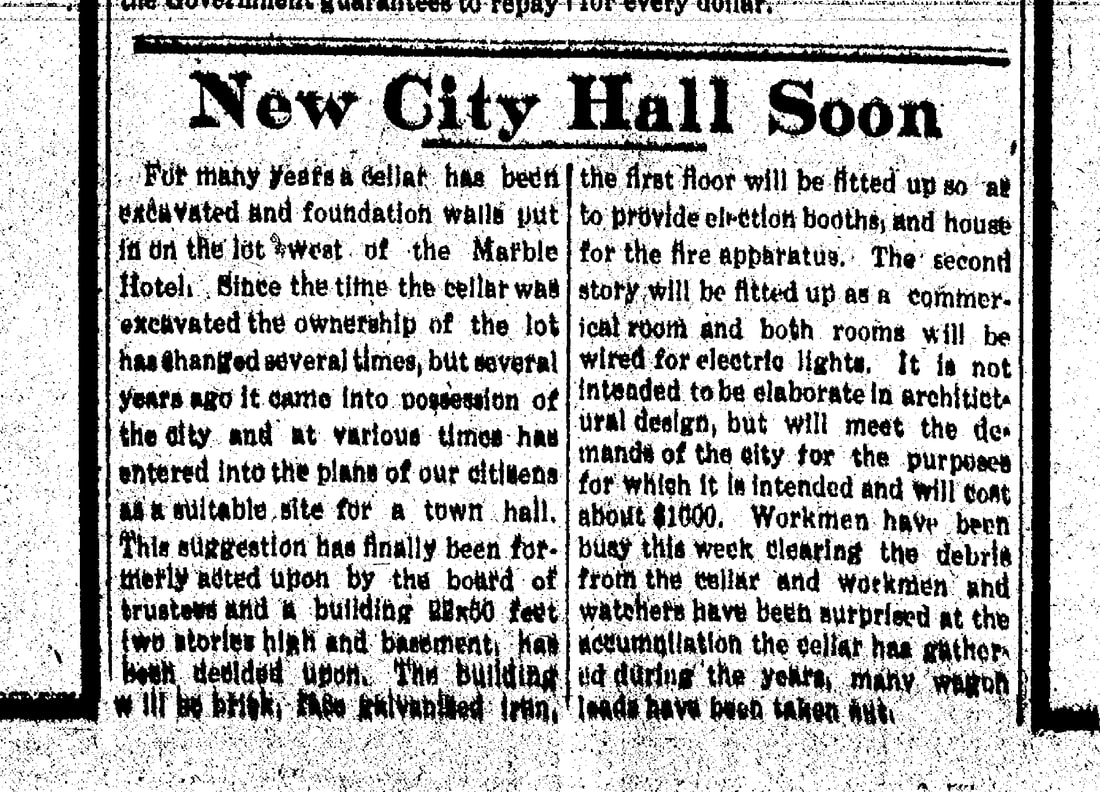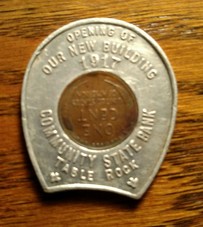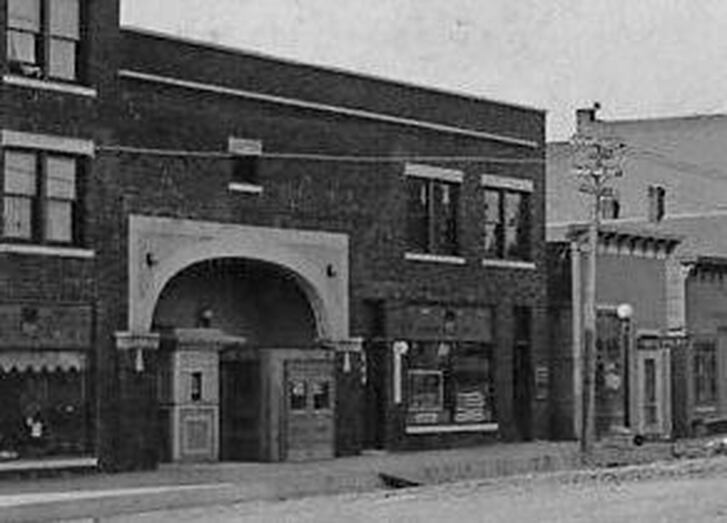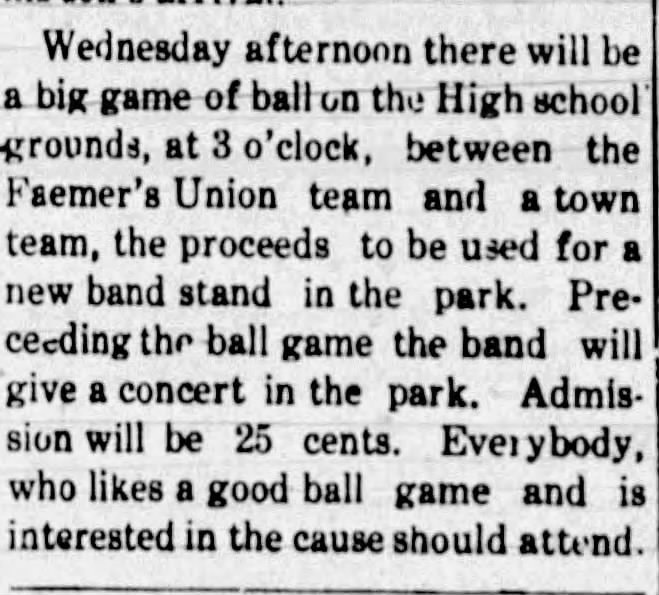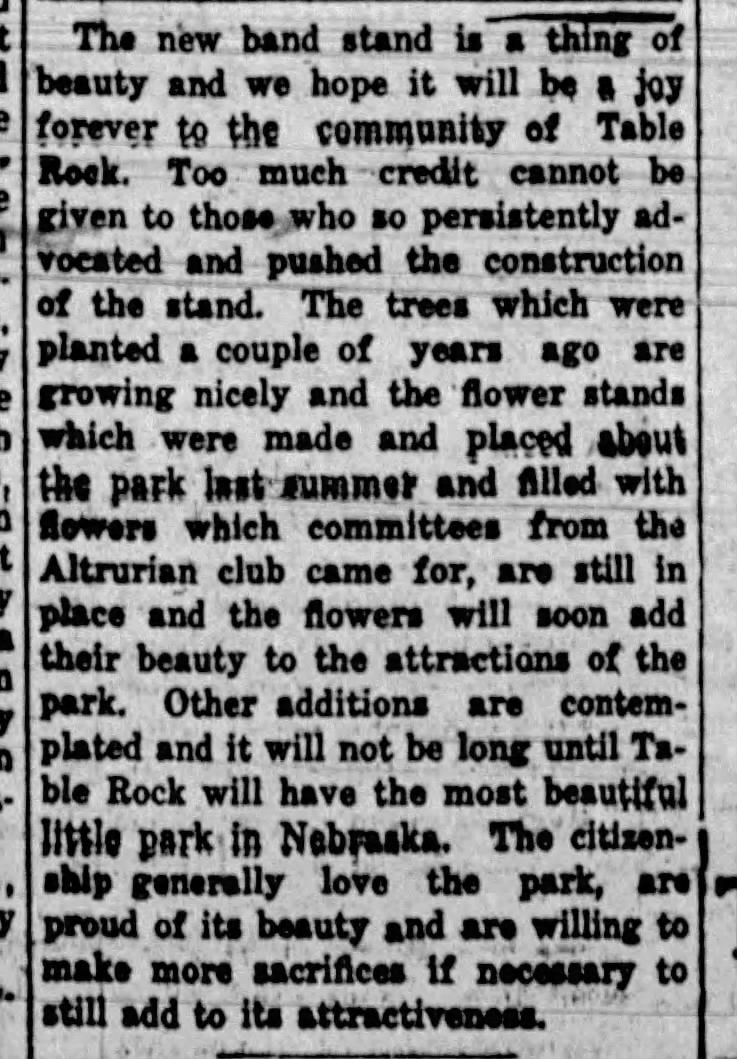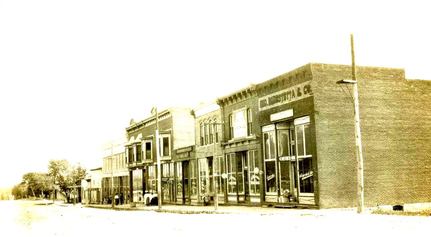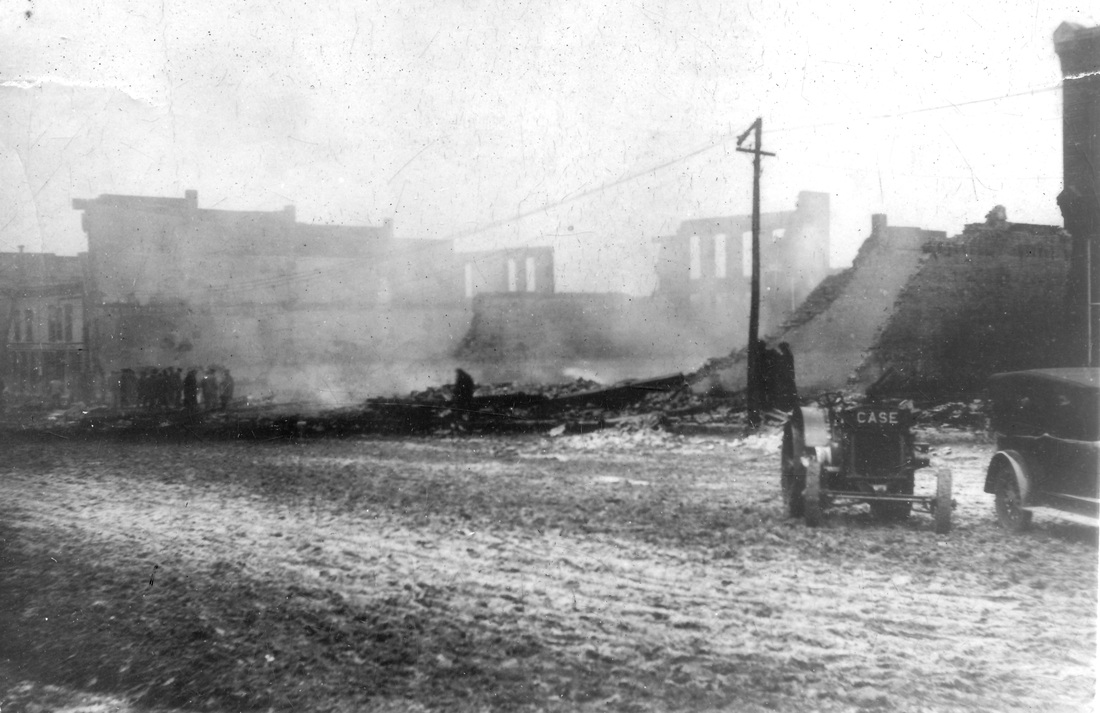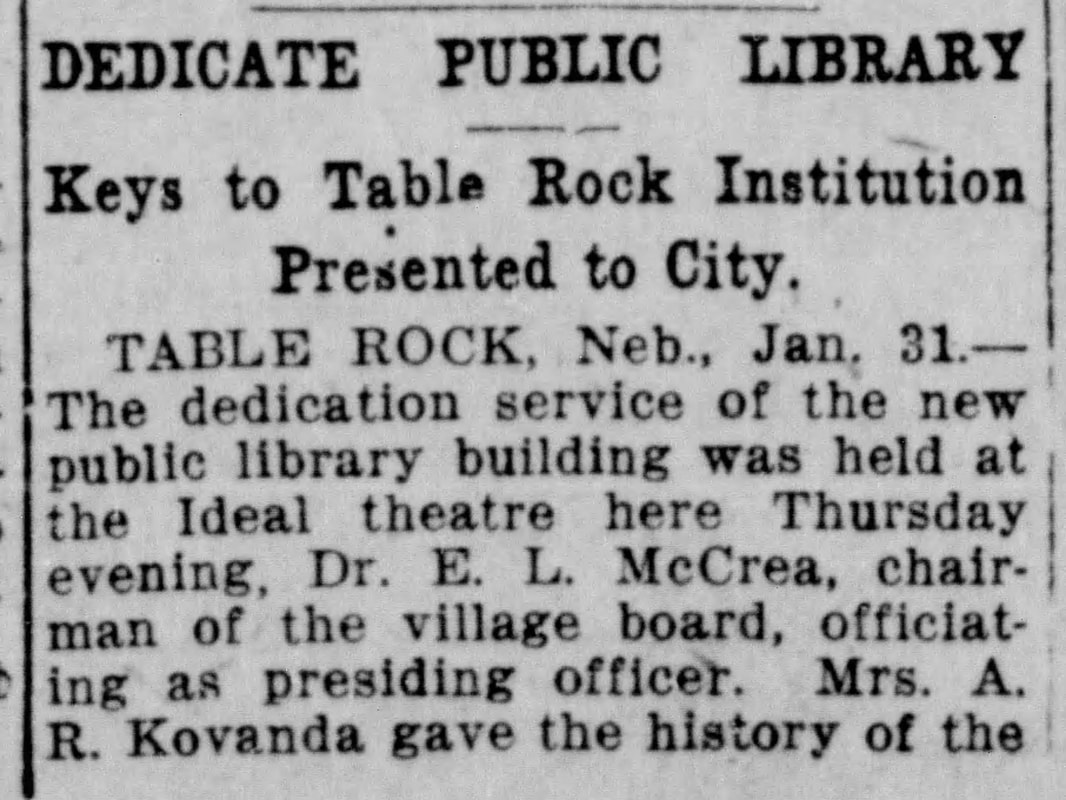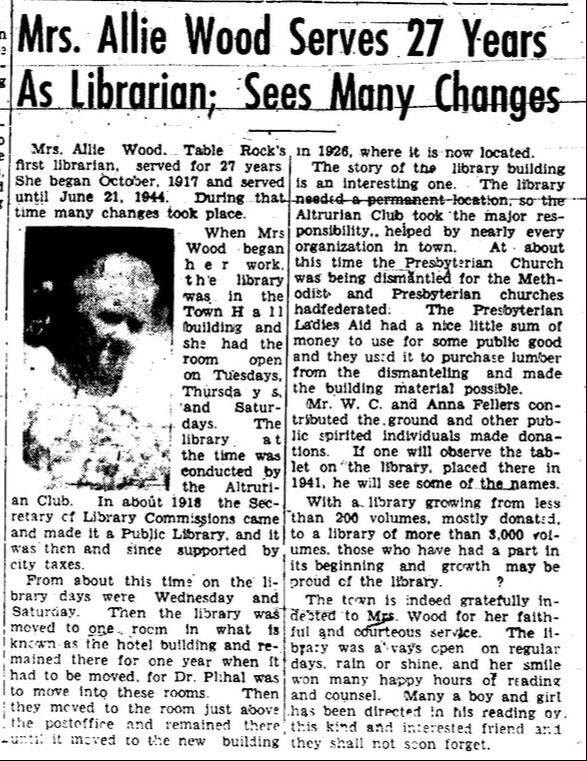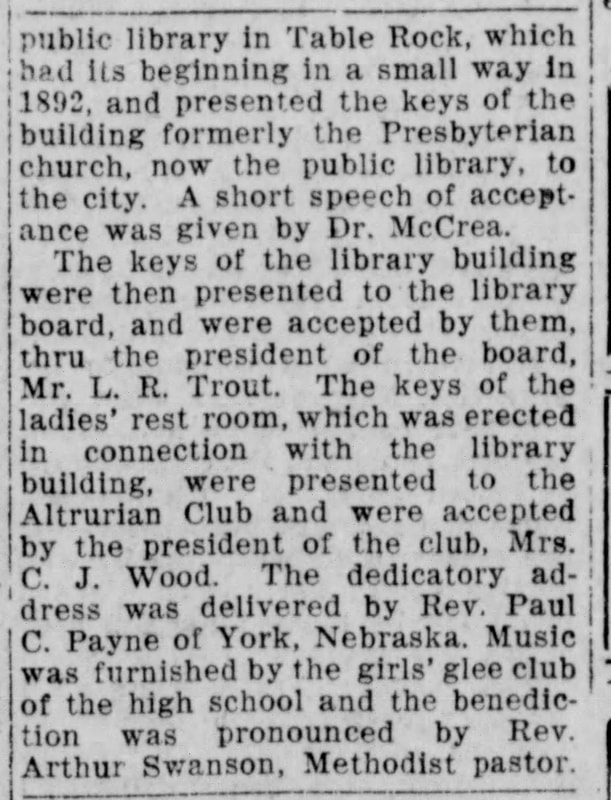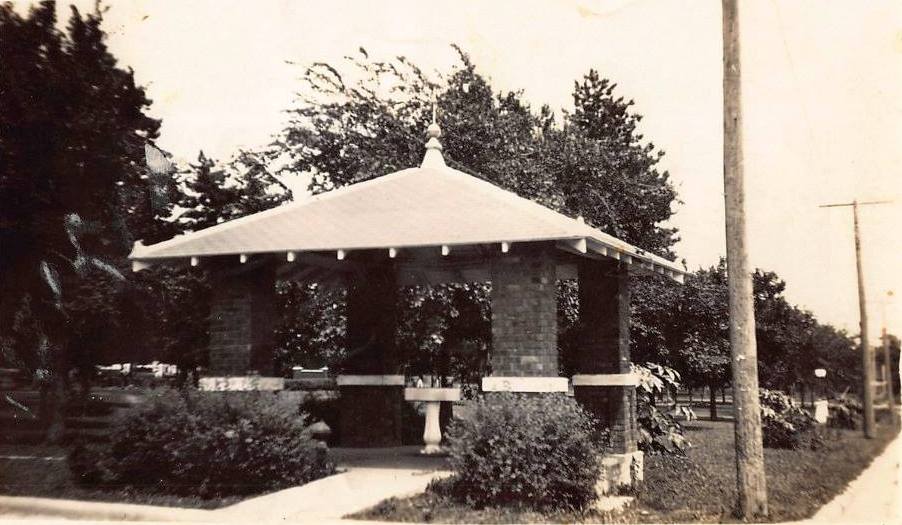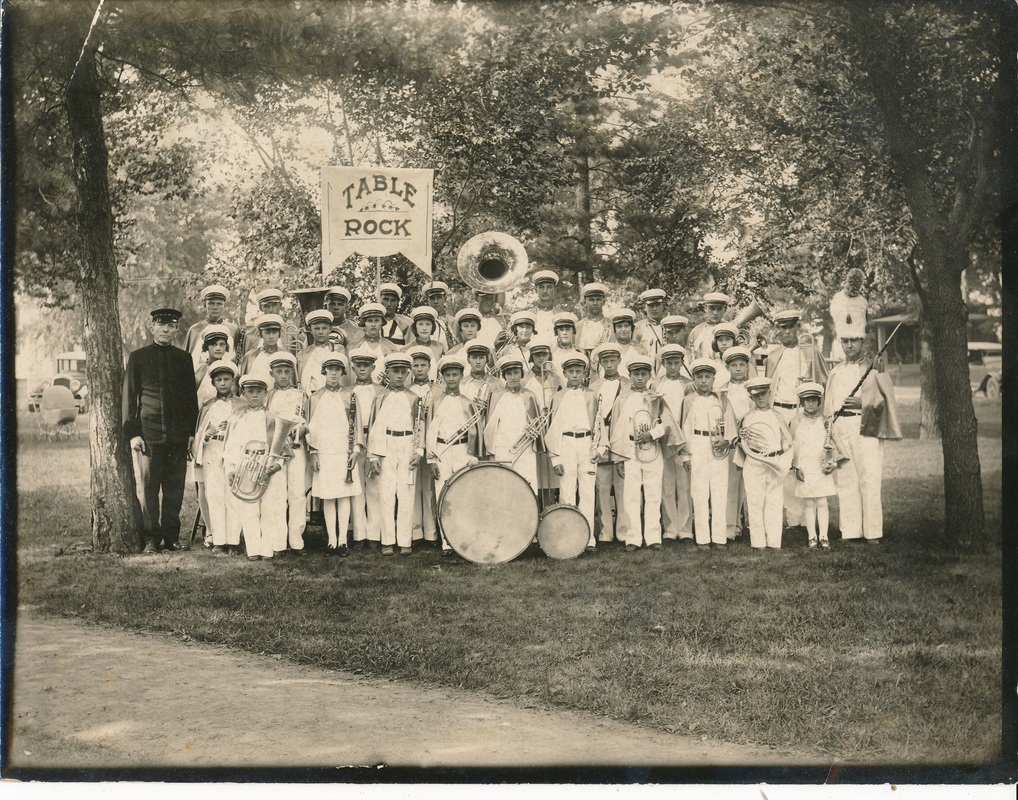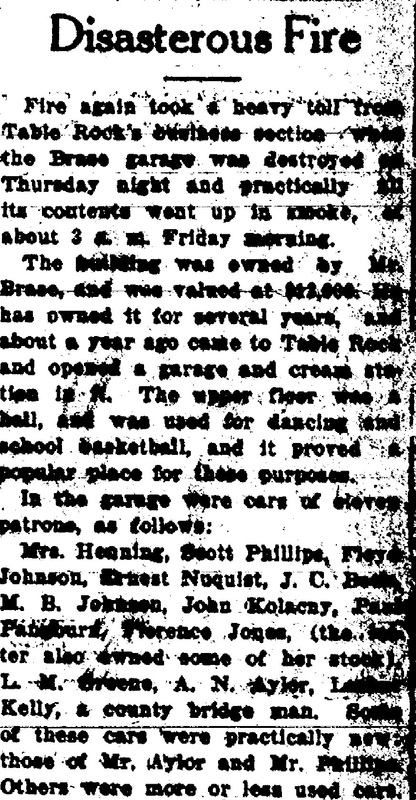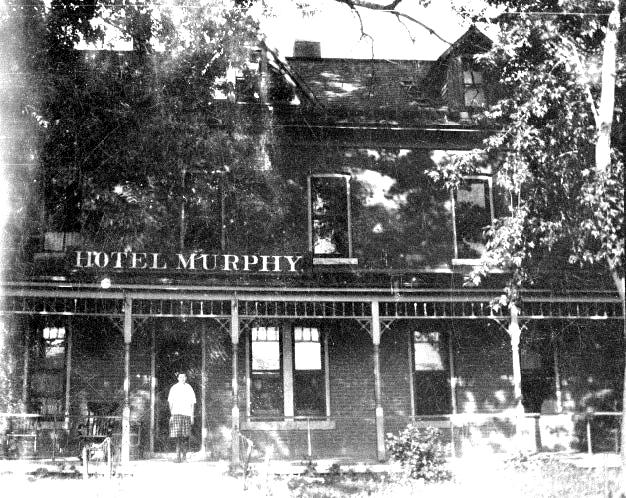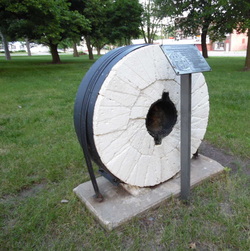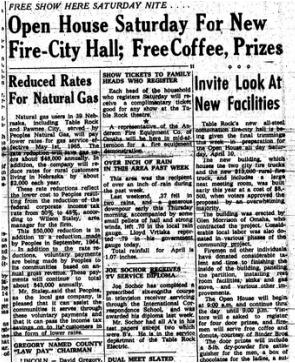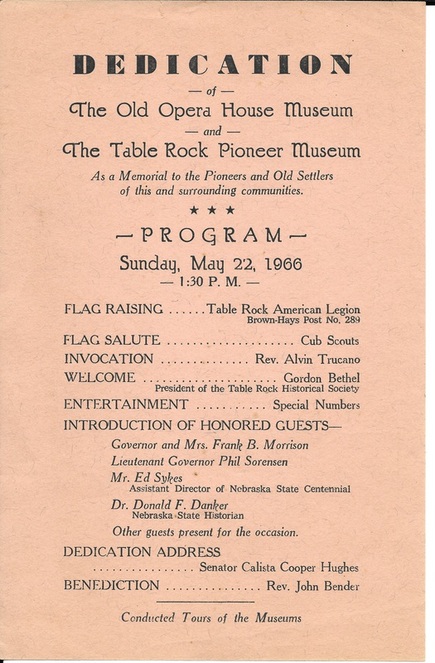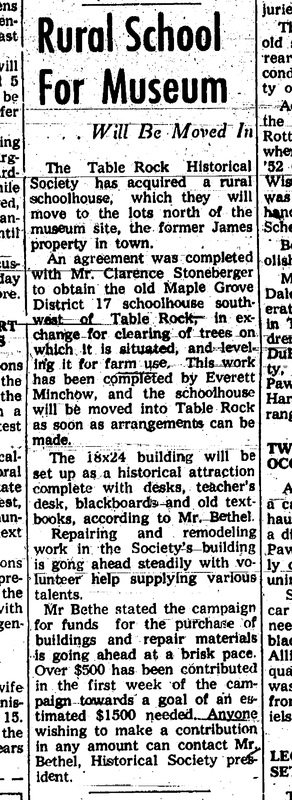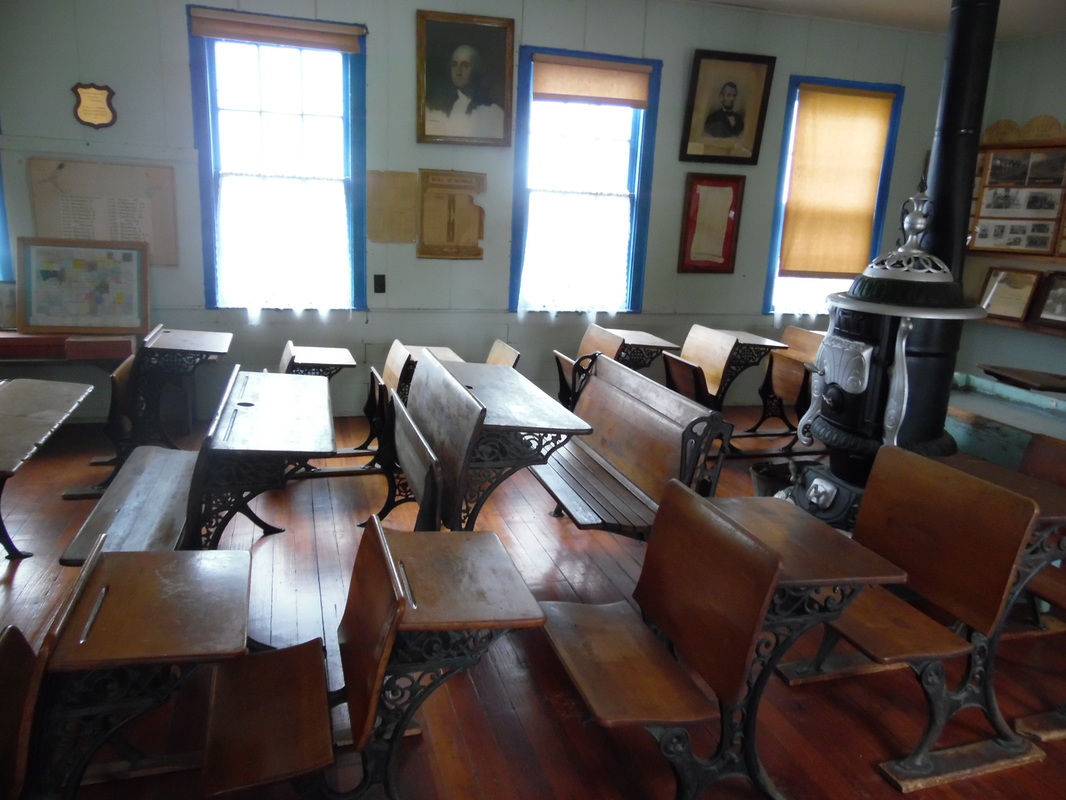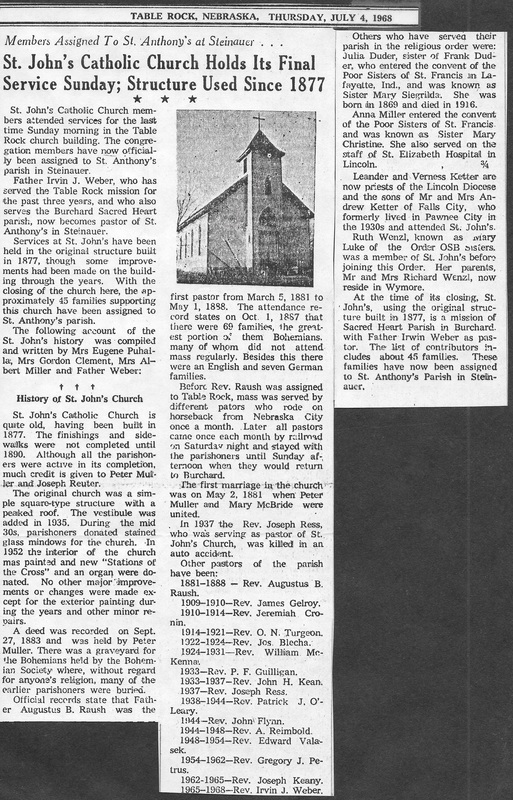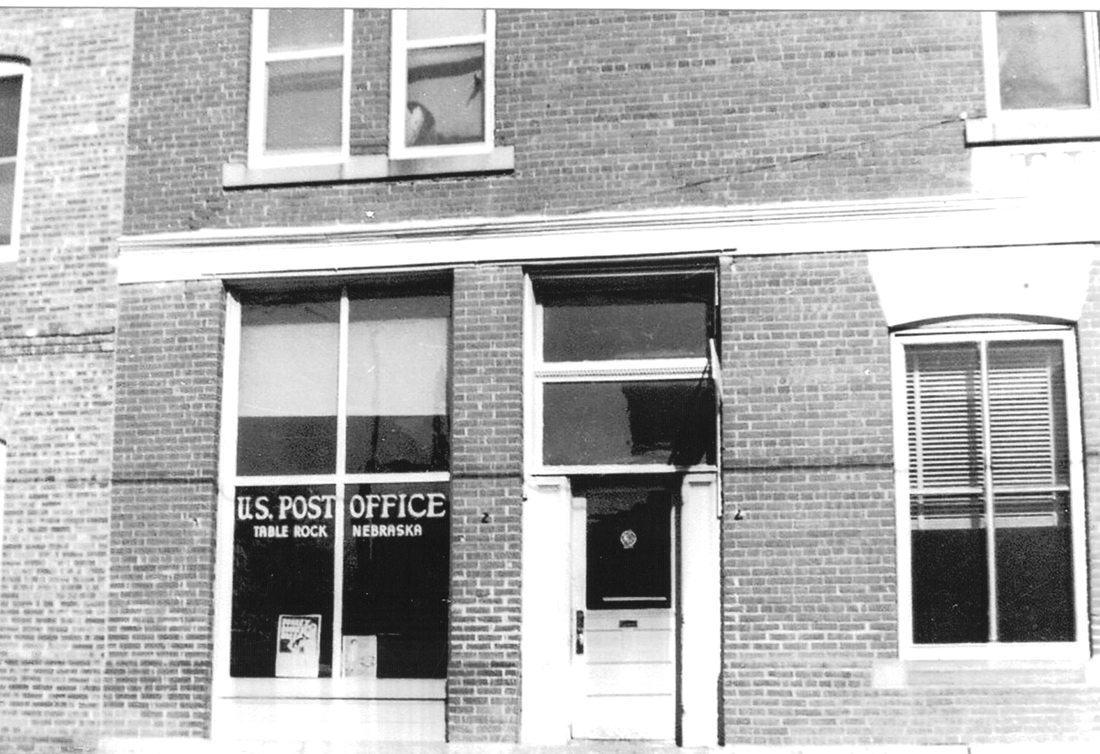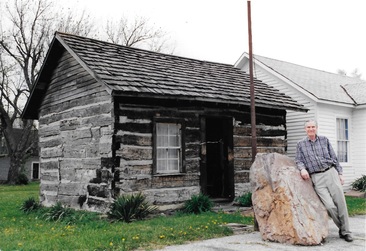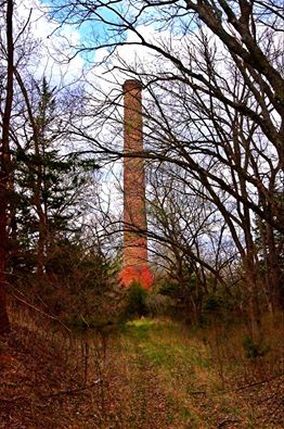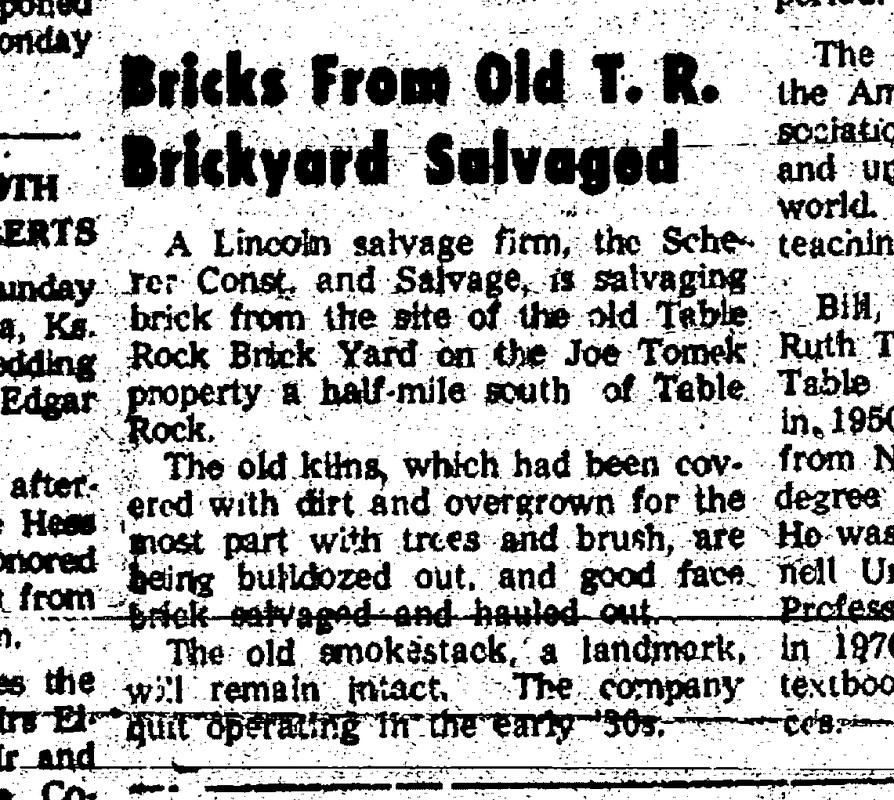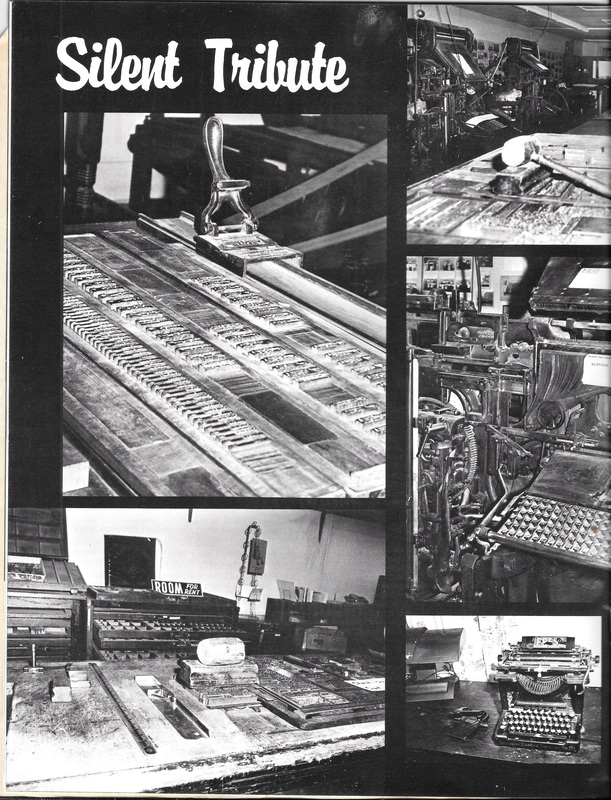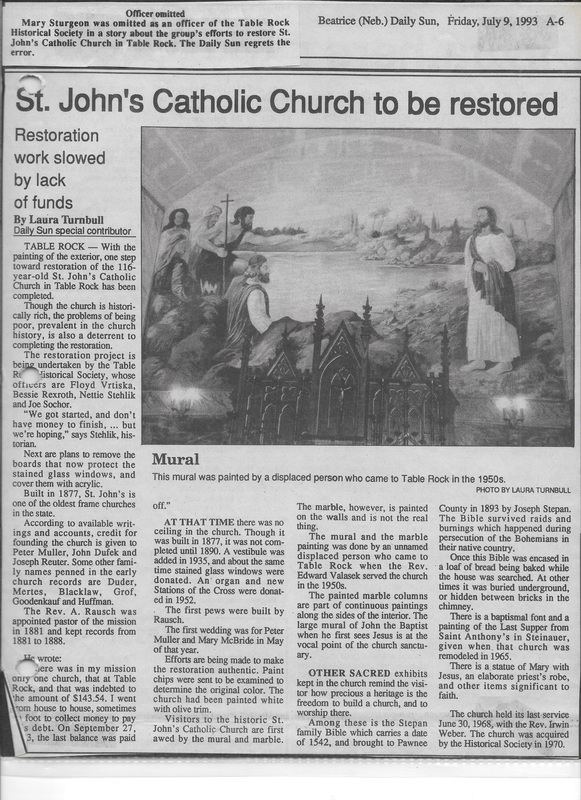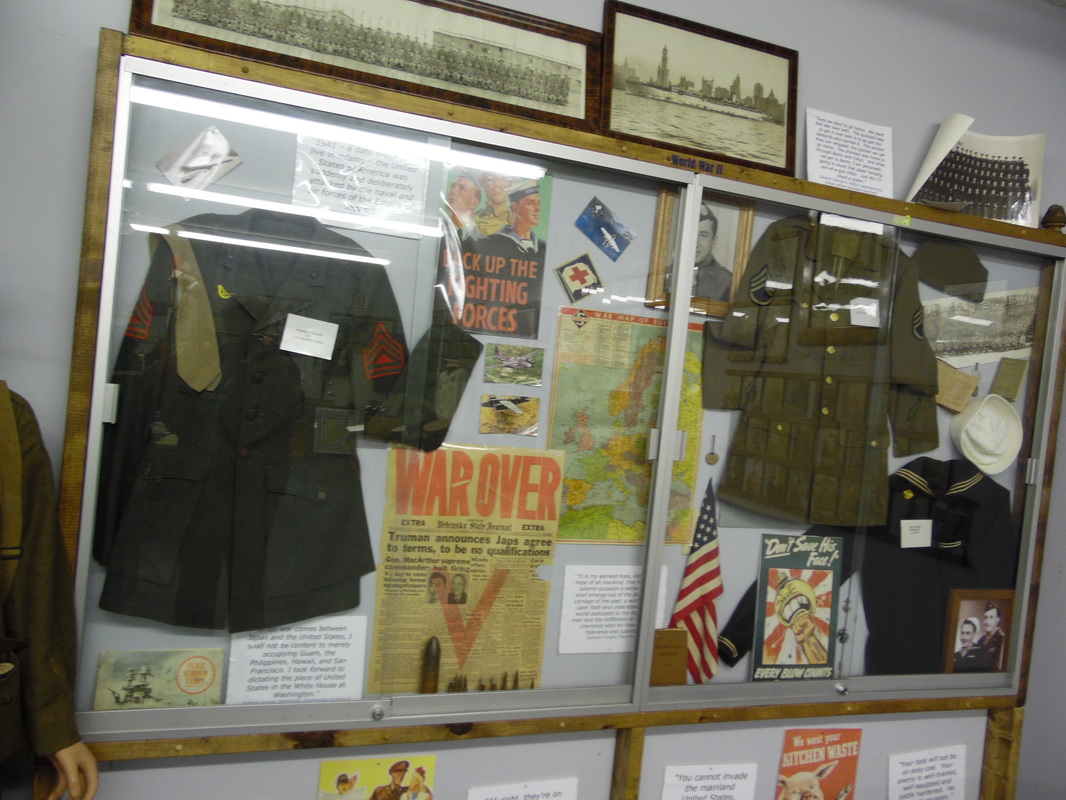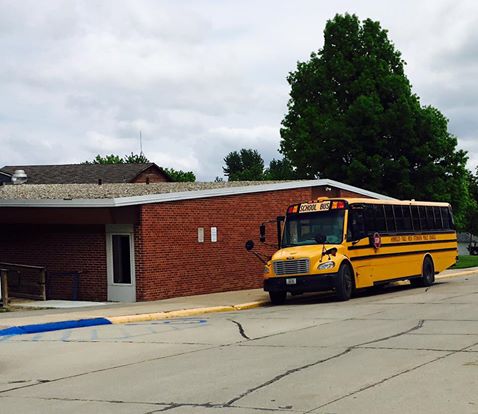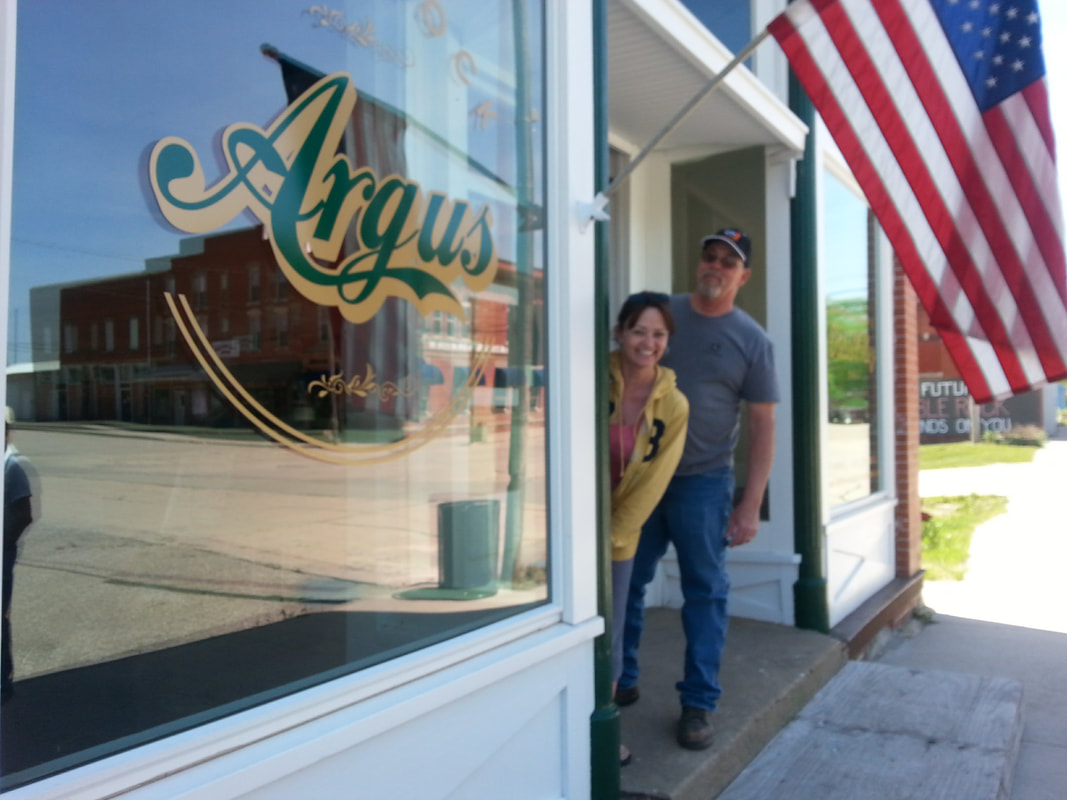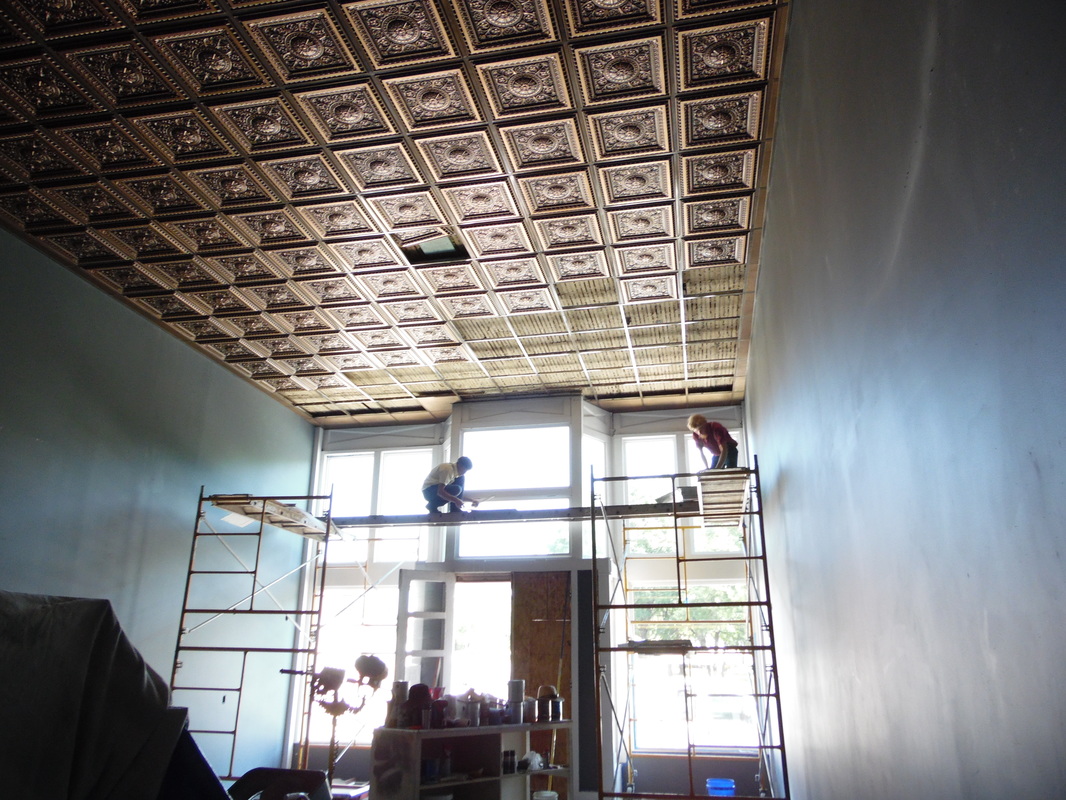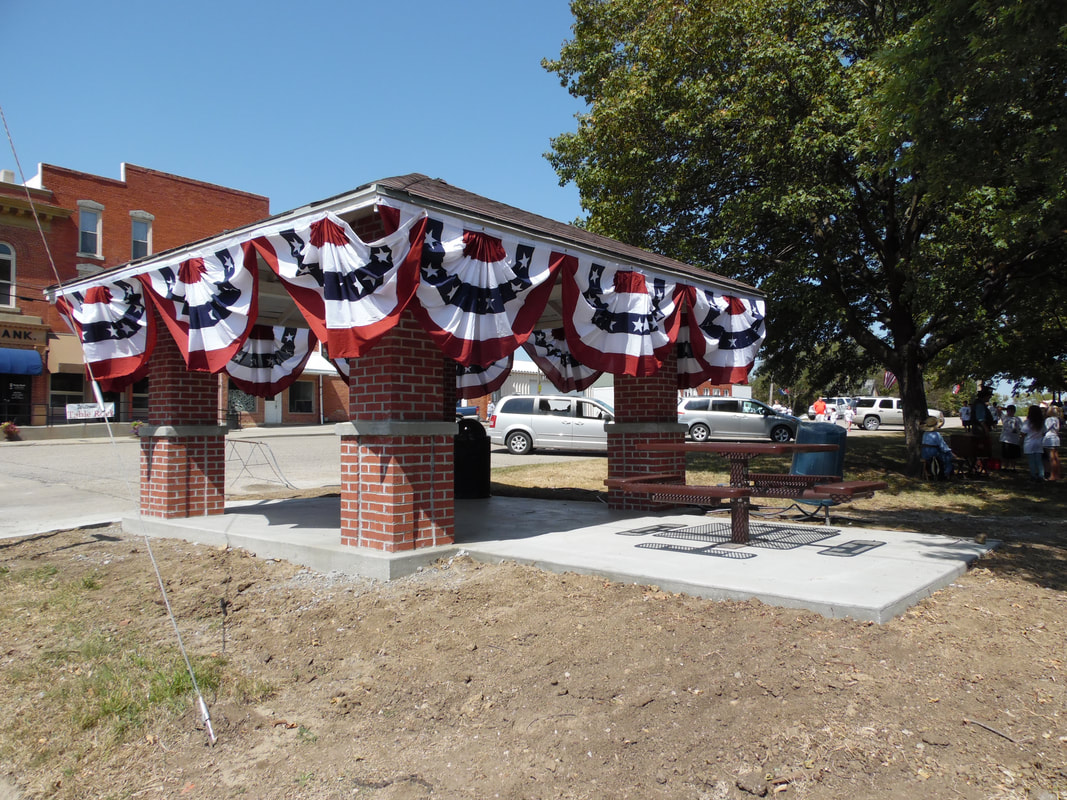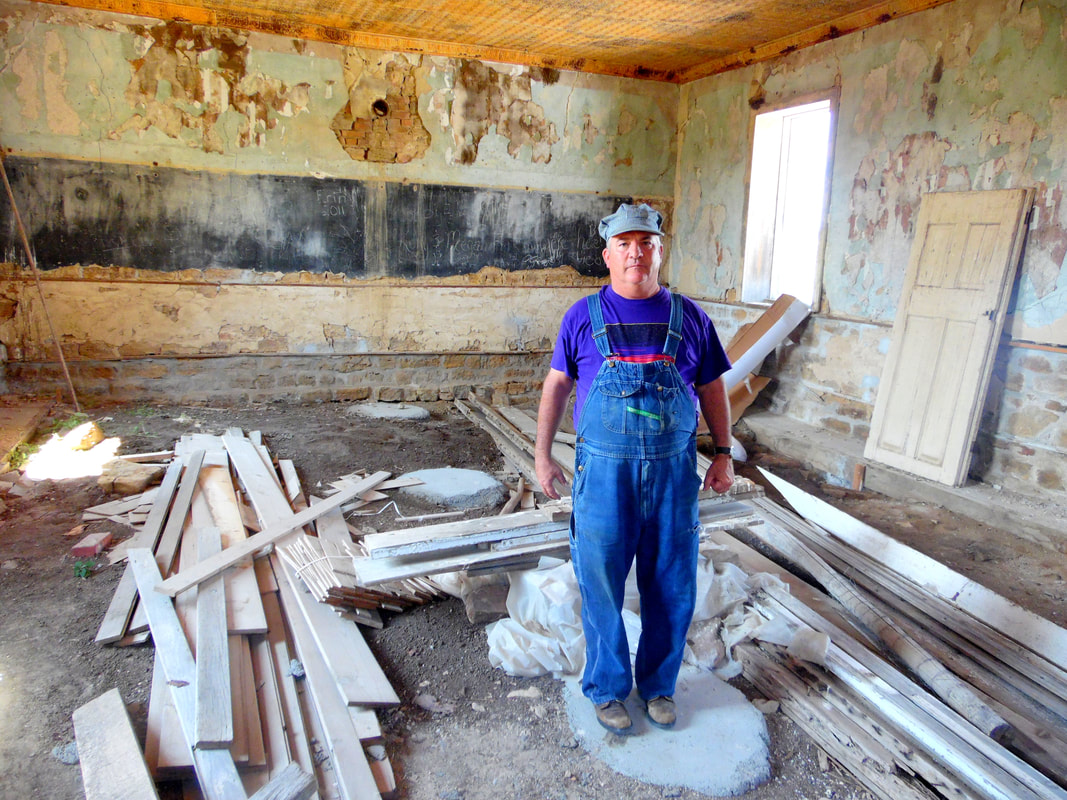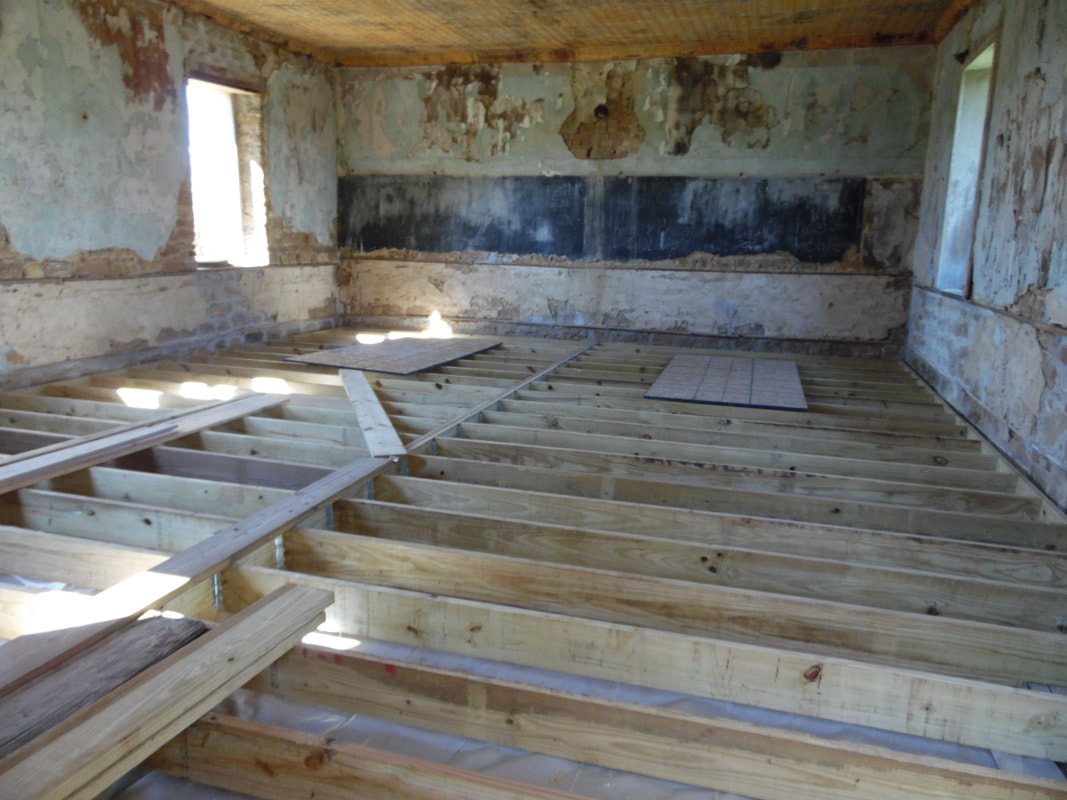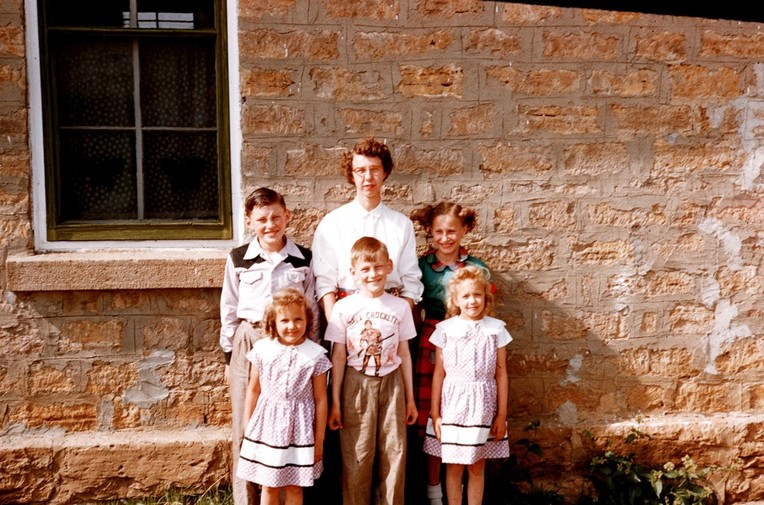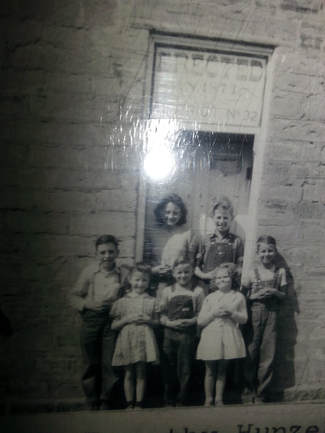table rock's TIME LINE
This page is always under construction. Often new facts are learned but the updating of the time line is overlooked. For example, it was originally thought that the old Legion Hall building was constructed in 1894, based on information in an application for listing in the National Register of Historic Places, but then a newspaper article was found saying that the building was being constructed -- on a basement facility that had been used as a lodge hall by the Woodmen of the World. If you see something that conflicts with information elsewhere on this website, please speak up & let us know. Email [email protected].
|
How did all of this come to be? Baby steps, then by leaps and bounds, then still forging ahead with determination. Here are some events in our history that have made us what we are today. Have an idea for something to add? Email us at [email protected], or post it on our Facebook group page.
|
1854 - FIRST SETTLER IN TABLE ROCK AREA ARRIVES, JAMES HINTON; ERECTS SMALL FRAME HOUSE, MILL BUILT ON SITE BEFORE LONG
1854 - FIRST COUNTIES ESTABLISHED, TEMPORARY COUNTY OF RICHARDSON COUNTY EXTENDS 60 MILES FROM THE MISSOURI
1855 - PAWNEE COUNTY ESTABLISHED, WESTERN PART OF TEMPORARY RICHARDSON COUNTY
1855 - TABLE ROCK TOWN COMPANY ARRIVES, BEGINS SURVEYING; three men comprise the company, iNCLUDING FUTURE GOVERNOR robert FURNAS. they "partially lay out" the town.
|
A later history said: The Indian trail forded the North Fork of the Nemaha about two miles north of town. The wagon trail ran from the northeast to the southwest. The "remarkable stones" were on a bluff on the east side of the river. They were of standstone, 18 to 20 feet high, and "covered with unintelligible hieroglyphics." One was shaped like a table, nearly high enough to stand under.
|
1855 - FIRST CHILD BORN IN PAWNEE COUNTY, TO ROBERT & mary TURNER, WHOSE CABIN (BUILT IN 1854) WAS LATER MOVED TO TABLE ROCK AND BECAME A MUSEUM
1856 - FIRST ELECTION FOR PAWNEE COUNTY SEAT. TWO TABLE ROCK SITES PROPOSED, THE "TOWN" SITE, AND A SITE ON THE HILL JUST EAST OF THE RIVER, AND A THIRD SITE ON TURKEY CREEK. NONE OF THE THREE SECURED A MAJORITY VOTE, with "Table Rock City" only one vote shy of getting the necessary votes. IN A SECOND ELECTION, THE TURKEY CREEK SITE WON OUT. PAWNEE CITY DEVELOPED THERE.
|
1856 - DECEMBER. FIRST POSTMASTER APPOINTED.
1857 - NEBRASKA SETTLEMENT COMPANY PURCHASES INTERESTS OF TABLE ROCK TOWN COMPANY FOR A REPORTED $1,500, AND FIRST FAMILIES WITH THE NSC ARRIVE.
1857 - FIRST SCHOOL CLASSES TAUGHT. (AT LEAST ONE HISTORY GIVES 1856 AS THE FIRST YEAR THAT SCHOOL CLASSES WERE TAUGHT, BY LYDIA GRIFFING IN HER LOG CABIN. HOWEVER, THE 1882 ANDREAS HISTORY GIVES 1857 AS THE DATE OF ARRIVAL OF THE GRIFFINGS.
1857/1858 - Robert v. Muir prepares a plat of table rock in 1857, recorded at the courthouse in 1858. platt includes the town square and the table rock cemetery.
1858 - table rock is incorporated
1858 - DATE ON LIMESTONE TOMBSTONE IN TABLE ROCK CEMETERY
|
1858 - table rock incorporated
According to the memoirs of Rev. C. W. Giddings, the founder of Table Rock, Nebraska Territory towns could be incorporated by operation of law in 1857 if published certain notices in the newspaper, and Table Rock did. Perhaps it helped that one of the earlier "founders," Furnas (of the Table Rock Town Company), was the editor of the new and influential Brownville Advertiser newspaper. There was no paperwork, apparently, towns were just deemed incorporated. This makes sense in a time when Nebraska Territory was just getting settled and towns were springing up everywhere. How could the brand new Territorial government keep up with the incorporations if they did it one by one! However, according to the 1880 Andreas history, this did not happen until 1858. An edition of the Table Rock Argus in the 1940s reported that it was on July 20, 1858. (No source was cited.) Table Rock was established about 1855-- the Table Rock town company partially laid out the town then; there was a mill and a place called Table Rock then, and to it came the first families of the Nebraska Settlement Company in 1857.
| |||||||
1859 - MILL OPERATED BY MR. FLEMING AT TABLE ROCK NOTED IN PIONEER RECOLLECTION
1859 - a traveler describes "the" table rock
In an article about a trip to Table Rock, the traveler, identified only by his initials, describes the mill, the town, and "the" Table Rock. This is article is extremely valuable historically, because it seems to be the only contemporaneous account of what the actual Table Rock looked like. It was gone within about a decade. Many people described talked about the Table Rock, but they were referring to another formation, usually the Mushroom Rock, which was dynamited after it became unstable due to a lightning hit.
|
Whatever happened to "the" Table Rock? Elsie Pepoon Sutton interviewed who had seen it for themselves and who were still alive in the early 1930s. By that time, the original rock was long gone but no one knew when or why or how.
| |||||||
1860 - TABLE ROCK INCORPORATED -- again! |
1862 - FIRST SCHOOL BUILDING IN TOWN, A ONE-ROOM STONE BUILDING JUST EAST OF THE SOUTHEAST CORNER OF THE SQUARE |
1864 - three horse thieves hung in table rock: jim riley, joseph catrin, paul clifton |
1865 - EXPRESS ROUTE RAN THROUGH TABLE ROCKIra Draper's obituary refers to the "pony express" but it had be long gone when he rode in 1865. But that does not mean that there was not an express rider who carried the mail. The Pony Express was forced out of business by the transcontinental telegraphy. In 1865, there was no telegraph across southeast Nebraska. That came with the railroad in 1871. In any event, the obituary recites:
Ira would start early in the morning from Falls City.....From Humboldt, the trail ran across the hills to Table Rock and then on.... |
1869 - C. H. Norris store established
|
Chauncey H. Norris went into business in Table Rock before the Civil War, married Fannie Giddings (daughter of the town's founder), fought in the Civil War, served as an Indian agent, then returned to Table Rock for good. He set up his first store in 1869. He later moved it to Lower Town (the Railroad Addition) after businesses moved there to be near the depot, and then moved back up town when the businesses did so to avoid troublesome flooding.
|
1872 - the Odd fellows lodge organized
The seven charter members included three whose presence in our local history has been iconic: C. H. Norris, R. P. Jennings, M. H. Marble, and Dr. J. W. Lindsley, who built the Lindsley House Hotel, and three others whose significance has been lost to time—Horace Niles, W. B. Bull, and James O. Tuttle.
1873 - FIRST METHODIST CHURCH BUILT, IN LOWER TOWN (DATE APPROXIMATE, IS DATE OF MORTGAGE LIEN ON THE PROPERTY
1873 - pleasant valley country school -- the rock school -- built in old school district 32.
1874 - maple grove country school (ALSO KNOWN AS THE MUMFORD SCHOOL) is built IN SCHOOL DISTRICT 17, WEST OF TABLE ROCK. IT WOULD BE MOVED INTO TABLE ROCK & opened AS A MUSEUM WHEN IT WAS 92 YEARS OLD (1966).Source: 1917 student history of Maple Grove; many of the school districts produced such a history as part of a project that year. The history is in the archives of the Nebraska State Historical Society.
|
1874 - SECOND SCHOOL BUILDING IN TOWN. TWO-ROOM FRAME BUILDING ON SITE OF STONE SCHOOl
1880 - the table rock cemetery association formed.
1881 - FIRST TRAIN ON THE WYMORE EXTENSION OF THE REPUBLICAN VALLEY RAILROAD, I.E., THE "WYMORE LINE"
1881 - first 2 brick commercial buildings built
|
The 1st building was the Odd Fellows building at the southwest corner of the Square; that building burned in 1900. The second building was the Richardson building, built later that same year; in the 1900s it was successively owned by Frank Sochor, Joe Sochor, and Harry Griebling. The source of this information is a January 3, 1901 article in the Argus about a fire that destroyed the Odd Fellows Building (which was soon replaced).
|
1882 - FIRST BANK IN TABLE ROCK ESTABLISHED
1885 - STATE BANK OF TABLE ROCK FOUNDED
1888 - first high school graduation (2 students)
1892 - STATE BANK OF TABLE ROCK dedicated
From “Hassler’s – History of Pawnee County 1896.”
“The first bank in this town was started by W. M. Forbes and Wheelock. On the second day of November 1885, they were succeeded by the State Bank of Table Rock...started with a capital of $10,000... In 1892, a fine two story brick building was erected at a cost of $5,500, which was used as the bank’s home. It is finished throughout in an elegant manner, the counters being made of birch wood. The valuables of this institution are safely ensconced in a Diebold safe surrounded by a strong brick vault, which makes it perfectly secure. It is supplied with all the appliances for safe and conservative banking."
“The first bank in this town was started by W. M. Forbes and Wheelock. On the second day of November 1885, they were succeeded by the State Bank of Table Rock...started with a capital of $10,000... In 1892, a fine two story brick building was erected at a cost of $5,500, which was used as the bank’s home. It is finished throughout in an elegant manner, the counters being made of birch wood. The valuables of this institution are safely ensconced in a Diebold safe surrounded by a strong brick vault, which makes it perfectly secure. It is supplied with all the appliances for safe and conservative banking."
1893 - the opera house opensDownload a detailed history of the opera house by Duane Fike, "The Table Rock Opera House, 1893-1900: A Small-Town Community Center," Nebraska History 58: 149-174.
|
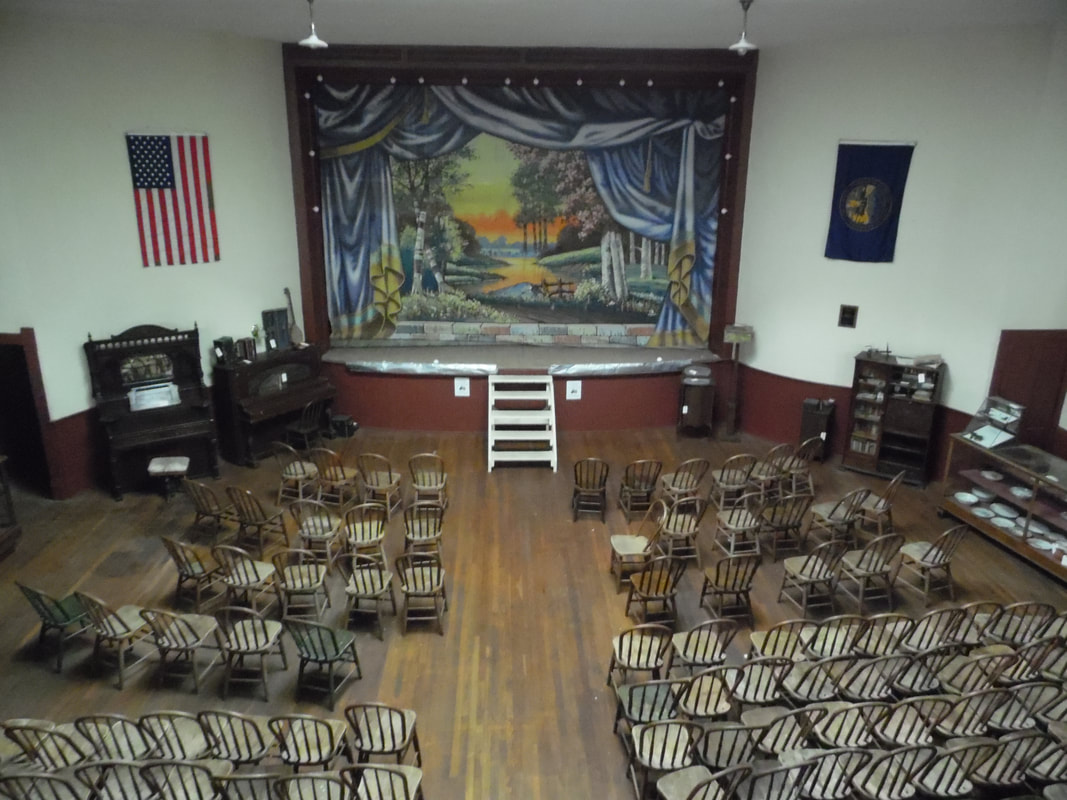
From Duane Fike's history: "The front of the stage opening, or proscenium arch, resembles a giant gold-tone picture frame. The opening is 20 feet, 4.inches wide and 13 feet, 6 inches high. The gold-painted border measures 20 inches wide and is decorated on the sides and top with recessed panels, each 6 feet long .and 9 inches wide. On the upper side panels and across the top are sixteen porcelain light sockets for incandescent bulbs. Four narrow gold panels fill in the area between the ceiling and the border at the top of the arch. Partially rolled up behind the arch is the front stage curtain, a canvas drop with painted "draperies" framing a pastoral scene."
| ||||||
1896 - william jennings bryan visits |
1896 - table rock marshal nick craig murdered |
1899 - fire department organized
|
The March 2, 1899 Argus reported that the "newly-organized" fire company would that Saturday evening. The roster was detailed. Dr. C. C. Covert was the chief, A. C. Boyd the Assistant chief, C. R. Judkins, President; Henry Shaw, Secretary; C. J. Wood, Treasurer;l and Will Ward, Steward. Members also included Roy Martin, George Cotton, C. I. Norris, C. C. Norris, and Art Longwell, amongst others.
|
1900 - table rock population reaches its all time high, 852. population of the county is 11,770
1900 - TABLE ROCK MILL CEASEs OPERATION (APPROXIMATE DATE)
1900 - J. c. Beck's FRAME LIVERY STABLE BURNs DOWN. it was considered an old landmark back then.The business was built by John C. Beck and William L. Taylor. Taylor sold out, built a brick building at the southwest corner of the Square, and opened a general store there; that building is now occupied by the Argus Museum. Beck continued on his own. After the fire, Beck built a brick livery stable to replace it. The stable had a second floor, which was then called a "hall." It was reportedly used for meetings and dances. The ground floor was taken over by various owners and, in 2019, has been occupied by Sitzman Repair for many yeas.
|
1901 - POST OFFICE ESTABLISHES FIRST RURAL ROUTES, WILCOX & TALBOT THE FIRST CARRIER |
1902, march- new odd fellows building dedicated
1903 - table rock's brick yards turn out over 10 million bricks |
1912 - teddy roosevelt comes through
1917 - Norris Store moves to the Odd Fellows building
1918 - grand opening of hillman's ideal theater in the lincoln hotel block
Hillman's was the theater in the Lincoln Hotel Block, later re-named the Roxy, then simply the Table Rock Theater.
1918 - the influenza pandemic
|
In October 1918, the influenza pandemic that had been raging around the world for months hit Table Rock. Deaths continued into January 1919.
|
1919 -- band stand in the square built
Successful fundraising efforts led to the construction of a new bandstand in the Square. The date of the denoument of the old wooden bandstand is unknown.
|
|
1920 - "THE" FIRe
1926 - library dedicated, public ladies' restroom opened
It was not the first location for the town's library, but it has been the last. It is still in the building constructed in 1926 with lumber from the dismantled Presbyterian Church purchased by the Alturian Club A public ladies' restroom was part of the construction; it was run under the auspices of the Alturian Club; a much later remodeling of the building expanded the library, eliminating the restroom. The library stands on land donateld by W. C. & Anna Fellers. They had a grand store on the south side of the Square, which they lost in the great fire of 1920. They rebuilt, but it was a modest little building, known to most as the old Lang's Locker. This was across the street from one of the earlier locations of the library, the Village Hall built in 1915 (later the village maintenance building, now in private hands). It is a couple of doors down from the State Bank of Table Rock, whose building was expanded into the old post office; the library was above the post office when the new one was built in 1926.
1926 - WATER FOUNTAIN gazebo BUILtThe gazebo -- originally called a pagoda -- was placed atop the old city well when it was abandoned in favor of a "water works," which incorporated the first water tower.
|
1929 - FIRST HIGH SCHOOL BAND ORGANIZED & is wildly successful |
1930 - fire at the lincoln hotel block |
1934 -- AUDITORIUM & GYM ADDED TO THE BRICK SCHOOL
1937 - SHEPHERD trades his TWO-WAY INN TO george SLAUGHTER for a farm, slaughter RENAMES IT THE RENO INNTed Quackenbush shared a lovely story about the adoption of his wife Nancy by Hugh and Ruby Shepherd McAlpine, and in it, the family at one point moved back to Nebraska to live with the Shepherds at the farm that had been traded for the inn.
|
1939 - burr stone (MILL STONE) FOUND IN 1938 BY CHARLIE HARLOW INSTALLED IN THE SQUARE AS A MONUMENT |
1963 - brick schoolhouse torn down |
|
1965 - new fire hall dedicated
1968 - 50 YEAR TIME CAPSULE DEDICATED (TO BE OPENED IN 2018)
1970 - ST. JOHN'S CATHOLIC CHURCH DONATED TO HISTORICAL SOCIETy
1974 - BELOVED ARGUS EDITOR
|
|
1988 - depot demolished after severe damage in derailment accident |
|
2013 - MUSEUM AT ST. JOHN'S CATHOLIC CHURCH RESTORED AGAIN |
|
2016 - grand reopening of ARGUS newspaper MUSEUM & PICTURE GALLERY renovated |
2017 - "new" water fountain gazebo
|
By 2014, the gazebo (built in 1926) had acquired a serious list that was not repairable. The roof was still in good shape. In 2017, the Village of Table Rock scraped the gazebo, saving the roof, which was put on a replica built as close as possible to the original. This historical rescue was made possible by a donation from the Table Rock Historical Society which covered much of the cost.
|
2017 - dedication of the restored "rock" country school
Perhaps inspired by the 50 years of "can do" spirit of the Table Rock Historical Society, a group of alumni of this country school -- built in 1873 -- formed the Rock School Foundation -- and restored their old school. It was dedicated on October 15, 2017.
